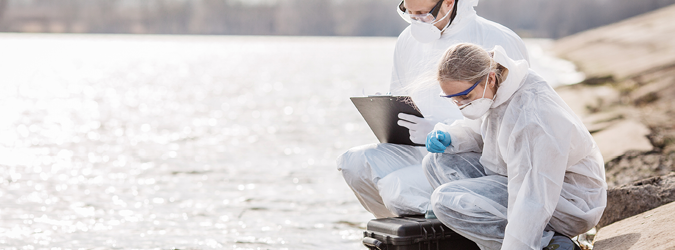The Dawn of Environmental Human Rights in New York
5.26.2023

New York’s Legislature had previously concurred, recognizing that these rights are “elemental.” At the New York State Bar Association’s Environment and Energy Law Section’s annual meeting on Jan. 25, 2022, I was privileged to deliver a lecture entitled “A New Era in Environmental Jurisprudence,” about what this Bill of Rights’ guarantee provides.[2] Little did I know then that Judge John J. Ark, of the Supreme Court in Monroe County, would later cite this lecture in the first judicial decisions applying New York’s newly minted Bill of Rights’ assurance of a personal freedom.[3] This article reflects on legal issues that are likely to emerge in ongoing adjudication about New York’s environmental right.
There are now four lawsuits pending in New York courts. The Elisabeth Haub School of Law at Pace University maintains an online Environmental Right Repository with the principal pleadings, decisions on motions and eventually all judicial decisions as they arrive.[4] The repository also provides references to analogous rulings in other states that provide rights to the environment in their constitutions, as well as to decisions in other jurisdictions around the world. Although the right to the environment is new to New York jurisprudence, for many years other common-law countries have been enforcing this right, as have other courts around the world. As Environmental and Energy Law Section members study and apply the New York right to the environment, many issues arise. Not least is that the human right to the environment is now also in the domain of human rights commissions and legal counsel’s offices for literally all state agencies. EELS may be a primus inter pares, given its environmental law expertise. However, just as due process of law is everyone’s concern, so too the environmental rule of law, both embodied in the same New York constitutional Bill of Rights.
The Human Right
The United Nations General Assembly took note of the widespread acknowledgement of the right to the environment in July of 2022, when it recognized “the right to a clean, healthy, and sustainable environment as a human right.”[5] An extensive analysis presented to the U.N. Human Rights Commission in Geneva, Switzerland, earlier demonstrated that the “vast majority” of nations have already recognized the right to a clean and healthy environment in their national constitutions and laws.[6] Legal scholars in the United States also have acknowledged or critiqued these rulings around the world.[7] Professors James May and Erin Daly have prepared a comparative law guide to judicial decisions applying environmental rights.[8]
It remains to be seen how New York courts will construe the constitutional guarantee to a clean and healthy environment. Because human health and ambient environmental situations are comparable around the world, and the duties established by environmental statutes are comparable worldwide, it is likely that rulings by New York courts will be akin to judicial decisions elsewhere applying environmental rights.[9] Like other provisions in the Bill of Rights (such as freedom of speech or freedom of religion), the constitution expressly prohibits government from trampling on the peoples’ rights, now also for a clean and healthy environment. As the Pennsylvania Supreme Court ruled in 2013, these fundamental rights “are inherent in man’s nature” and preserved rather than created by the Pennsylvania constitution.[10] The Pennsylvania court held that government’s ignorance about its actions harming a person’s environmental rights “does not excuse the constitutional obligation because the obligation exists a priori to any statute purporting to create a cause of action.”[11]
This right to a clean and healthful environment is a fundamental human right, upon which all other human rights depend. The state has a duty to uphold these rights.[12] Moreover, New York’s right to the environment underscores, and indeed elevates, all environmental justice claims in New York.[13] A government permit that allows environmental harm to persons in disadvantaged communities is legally suspect under New York’s Bill of Rights. Beyond environmental agencies, the New York Human Rights Division and local human rights commissions have a new legal impetus to bring relief to communities experiencing environmental discrimination because of race, color, national origin or income. Suits on behalf of each person denied clean air or clean water or a healthful environment may be directed at governmental human rights officials who fail to act to ensure observance of these human rights.[14] The reach of New York’s Bill of Rights in Article I, Section 19 will be surprising.[15]
Implications of the Initial Environmental Rights Rulings
New York’s decisions of first impression interpreting Bill of Rights Article I, Section 19 deserve thoughtful analysis. Judge John J. Ark independently arrived at a determination of law comparable to those of the Pennsylvania decision. The case involves long-standing complaints by persons claiming that their right to a healthful environment has been infringed upon by the governmentally licensed High Acres landfill in the Town of Perinton. Denying the motions to dismiss by the New York State Department of Environmental Conservation, the judge ruled that the right to the environment in New York’s Bill of Rights was self-executing and constituted a nondiscretionary duty on the part of all government agencies to fulfill their obligations under the Bill of Rights. Accordingly, plaintiffs could seek the remedy of mandamus. Moreover, plaintiffs had no obligation to exhaust any administrative remedies before seeking judicial relief and could do so within the six-year statute of limitations for constitutional claims (not the four-month limitation for CPLR Article 78 claims).[16] Judge Ark also ruled that the standards for judicial review of a constitutional claim are more rigorous than the “arbitrary and capricious” standards for administrative law claims. The burden of proof lies with the government to establish that it is not infringing a constitutionally guaranteed right. This shifts the burden of proof that environmental plaintiffs previously had to meet to the government defendant. As a corollary to this burden of proof, a number of courts abroad have adopted an evidentiary maxim known as in dubio pro natura, which means that when the evidence or equities are equally balanced, the court, to respect the right to the environment, adopts the finding that is most protective of the environment.[17]
The freedoms enshrined in the Bill of Rights, like due process of law, have ancient roots in the Magna Carta of 1215.[18] The environmental rule of law has its origins in the Forest Charter of 1217, which Magna Carta produced.[19] The human right to the environment is today considered to be an element of due process of law.[20] Thus, claims to enforce the right to the environment in New York arise also as claims to secure due process of law (U.S. Constitution Bill of Rights, Articles V and XIV, and New York common law due process). When claims are asserted by persons in environmental justice settings, they also arise as claims under Article I, Section 11 (equal protection of the law). Similarly, if a local government acts to prevent a person asserting the right to the environment, a claim involving freedom of speech arises under Article I, Section 8, and so too if freedom of assembly, to demonstrate for claims environmental right, is curtailed, claims could arise also under Article I, Section 9.
Given that the Bill of Rights now includes the fundamental human right to clean air, water and healthful environment, it is frankly surprising that Gov. Kathy Hochul and state agencies such as the Department of Environmental Conservation, and also Attorney General Letitia James and the Department of Law, seem to resist making the changes in policy and procedure required by Article I, Section 19. Judge John Ark raised this concern in his Fresh Air for the Eastside decisions: “Whether the Green Amendment will be an important tool to allow communities to safeguard their environment and compel state and local governments to prevent environmental harms is uncertain. Indeed, the vigor of the state’s opposition to this lawsuit does not bode well for its enforcement of the Green Amendment.”[21]
Responding to the Paradigm Shift
Judge Ark observed that the “regulatory paradigm in existence on December 31, 2021, as of January 1, 2022, has become a matter of constitutional right.”[22] One might expect that a local planning board, or bureau chief in the Department of Environmental Conservation, both understaffed and lacking sufficient resources to handle their respective workloads, might resist the paradigm shift. Certainly, the private sector in New York, including real estate developers, did not welcome the likelihood of a paradigm shift, as they lobbied hard against adoption of the Green Amendment in 2021. But that was then. As professor Rebecca Bratspies put it: “This changes everything.”[23] Nonetheless, state and local agencies appear to be ignoring the implications of the state’s human right to the environment.
All those in state government should take note of Judge Ark’s thoughtful opinions delivered at the end of 2022. Judge Ark ruled, “Complying with the Constitution is not optional for a state agency and is thus nondiscretionary and ministerial.” It is incumbent on state and local government agencies to exercise their due diligence to ensure that they respect each person’s environmental human rights. To do otherwise is to reject democracy. As Judge Ark put it, “The voters of this State have empowered impacted citizens to bring a Green Amendment case when their right to breathe clean air and live in a healthful environment has been violated.”[24]
New York’s environmental rights effectively prohibits any government agency from violating each person’s right to clean air and water and a healthful environment. When 70% of New York’s voters adopted these words, they understood their plain meaning. Legislative sponsors made clear they wanted the Green Amendment to be concise, akin to expressions of due process or free speech rights.[25] Environmental rights guarantee the right to life, which our era of climate change, biodiversity loss and chemical pollution places in some peril.[26]The birthrights to breathe clean air, have clean water, and live in a healthful environment are widely regarded as natural rights.[27] As is amply clear from applications of process of law, courts ascribe more precise meanings to the basic liberties in the Bill of Rights in context of the government’s act of trespass.
Objective criteria exist for the bench and bar, and government officials, to provide concrete meaning to clean air and water and a healthful environment. First, it’s fundamental to human rights law that the law can countenance no backsliding from levels of protection currently in place. This is the non-regression principle.[28] It has concrete meaning in the context of environmental law, for example the non-degradation of water quality norm that underpins the Clean Water Act and New York’s water quality standards.[29] It is evident in the duty to identify and adopt substantive mitigation of adverse effects under the State Environmental Quality Review Act.[30] This act also emphasizes the progressive nature of government’s objective, to improve and sustain improved conditions: “The maintenance of a quality environment for the people of this state that at all times is healthful and pleasing to the senses and intellect of man now and in the future is a matter of statewide concern.”[31]
Under Bill of Rights Section 19, governments cannot degrade the level of a person’s clean air and water and healthful environment. Agencies can take note of existing conditions, since they are the baseline below which degradation that impacts a person is proscribed. Without assessing the status of the local environment, agencies cannot know how their actions may cause degradation. This pre-action assessment is already required, but many agencies have ignored this duty. Such avoidance of this legal duty is at the root of many affronts to environmental justice.
When applying the right to the environment in context, Judge Ark provided a framework for judicial decision-making: “In adjudicating and applying the Green Amendment, it may be necessary to have a two-prong test. First, did the government action comply with the applicable statute? Second, did the government action violate a person’s constitutional ‘rights to clean air and water and a healthful environment?[‘”[32] If failure to adhere to a statutory duty is found, then a court may not need to reach the constitutional claim. In assessing the claim under the Bill of Rights, with the strict scrutiny appropriate when called upon to preserve the persons’ rights, Judge Ark’s test involves three considerations: (a) any agency’s infringement on an environmental right must be justified by a compelling state interest (not business as usual, or mere economic advantage); (b) the proposed agency conduct must demonstrate that it is the least intrusive (like the alternatives analysis required under the State Environmental Quality Review Act, or showing overall the act is not regressive); and (c) the action claimed to be a compelling state interest must still be consistent with the non-degradation and hold harmless the person’s environmental human rights (as in equal protection and environmental justice instances). Just as plaintiffs will need to assemble substantial evidence that the government is degrading the air and water to their detriment, defendants will face a daunting task to claim their act is compelling. There is not likely to be a large volume of environmental rights cases. If agencies reassessed how they respect each person’s environmental rights, litigation could be avoided altogether.
The Duties of the Executive Branch
Article IV, Section 3 of the New York Constitution obliges the governor to ensure that the “laws are faithfully executed.” The executive chamber should take stock of how manufacturing enterprises have learned to comply with environmental laws over the past decades. They created their own environmental management systems.[33] These systems allow any organization to adjust their operations to conform with legal norms for environmental stewardship.[34] Successful manufacturing enterprises also follow the environmental audit processes provided by the International Standards Organization.[35] The ISO 14,000 guidance series included provisions for independent audits of companies’ environmental compliance procedures.[36] In the course of doing so, they were able to streamline operations, minimize waste streams and modernize their operations.[37] It is time for government agencies to follow the best practices being used routinely by the private sector.
There are consultancies and training programs for EMS and ISO 14,000. Gov. Hochul, or the executive of any agency, can enlist these services to establish an EMS that aims to ensure that the governmental entity complies with New York’s environmental rights. Rather than opposing the right, as Judge Ark experienced, the Department of Law should counsel state agencies to review their operations to ensure compliance with human rights, including the right to the environment. Gov. Hochul should issue an Executive Order that each state agency adopt an appropriate EMS that ensures environmental rights are honored. There is a substantial practice for lawyers and environmental consultants in helping agencies learn to observe each person’s environmental rights.
Arguably, New York voters are distressed that their state’s ambient environmental quality continues to decline. They amended the Bill of Rights to secure their environmental liberty, a right to life. The incremental and cumulative impact of many pollutants or adverse land use changes add up. Governments are not preventing degradation. Many voters doubtless consider it a “crime” that their shared environment is being harmed by economic interests and temporizing, insufficient government regulation. The Bill of Rights, at least, now guarantees each person a right that she or he can bring to a court to vindicate.
Is it the dawn of a shift in how New York rebalances the equities toward affirming the right to life? Governmental agencies have tools to welcome the change or, as Judge Ark experienced, to fight to preserve their prerogatives and discretion to affirm business as usual. Ultimately, the Bill of Rights is in the hands of judges. Meanwhile, Gov. Hochul and Attorney General James have every opportunity to chart the paths to enable all governmental agencies to accept their human rights obligations.
The Bill of Rights’ paradigm shift in New York requires no less.
Nicholas A. Robinson is university professor for the environment at Elisabeth Haub School of Law at Pace University.
[1] N.Y. Constitution Bill of Rights, Article I, § 19, In force since Jan. 1, 2022. Colloquially known as the “Green Amendment,” voters accepted the right to the environment by a 2-to-1 margin, with 2,129,051 votes in favor of the amendment.
[2] Prof. Nicholas A. Robinson, Elisabeth Haub School of Law at Pace University, Presentation at the N.Y.S. Bar Association Annual Meeting before the Environment and Energy Law Section (Jan. 25, 2022), https://digitalcommons.pace.edu/lawfaculty/1205/.
[3] Fresh Air for the Eastside v. State, 2022 N.Y. Misc. LEXIS 8394, 2022 NY Slip. Op 34429(U) (Sup. Ct., Monroe Co., Dec. 20, 2022). and the companion case of Fresh Air for the Eastside v. Town of Perinton, No. E2021008617 (Sup. Ct., Monroe Co., Dec. 8, 2022).
[4] See https://nygreen.blogs.pace.edu.
[5] U.N. General Assembly Resolution A/76/300 (July 28, 2022), with 161 nations voting in favor including the U.S., and 8 abstentions, and no votes in opposition. See https://news.un.org/en/story/2022/07/1123482.
[6] This point was cited in the last preambular paragraph for the U.N. Resolution. See https://digitallibrary.un.org/record/3982508?ln=en.
[7] See James May and Erin Daly, Compendium of Global Environmental Constitutionalism: Selected Cases and Materials, U.N. Environment Programme & Widener University, 2019 (2d Ed.).
[8] James R. May and Erin Daly. Judicial Handbook on Environmental Constitutionalism (2017), http://works.bepress.com/james_may/100/.
[9] See, for instance, rulings in Hawaii, Montana, Pennsylvania Constitution Article I, § 27.
[10] Robinson Township, 83 A. 3d 901, 952 and n. 36 (Pa. 2013). The same finding was cited in the leading decision recognizing and enforcing the right to the environment abroad in 1993, by the Supreme Court of the Philippines, Oposa v. Factoran, by Justice Hilario Davide, Jr., https://lawphil. net/judjuris/juri1993/jul1993/gr_101083_1993.html. In Pennsylvania, the ruling struck down a state law (applied to legislative action); in the Philippines the ruling invalidated all the nation’s forestry permits (applied to executive action).
[11] Id., 83 A. 3d 901, at 952.
[12] The Bill of Rights Article I, § 19, then is to be applied as part of New York’s Human Rights Law, Chapter 18 of the Executive Law. See Article 15, Human Rights Law, § 290, Article 1, providing that the Human Rights Division is charged to uphold that Human Rights of New Yorkers: “The legislature hereby finds and declares that the state has the responsibility to act to assure that every individual within this state is afforded an equal opportunity to enjoy a full and productive life and that the failure to provide such equal opportunity, whether because of discrimination, prejudice, intolerance or inadequate education, training, housing or health care not only threatens the rights and proper privileges of its inhabitants but menaces the institutions and foundation of a free democratic state and threatens the peace, order, health, safety and general welfare of the state and its inhabitants.” See https://www.nysenate.gov/legislation/laws/EXC/290.
[13] Although the state Department of Environmental Conservation has policies and a modest program on Environmental Justice (see https://www. dec.ny.gov/lands/333.html ), the Legislature has enacted the environmental justice Permitting Bill, S.8830, which Gov. Hochul signed last Dec. 31, 2022, and which is due to come into force in June 2023. See https://www.nysenate.gov/legislation/bills/2021/s8830. The law amends the State Environmental Quality Review Act (SEQRA, Article Environmental Conservation Law) to require all state and local governmental agencies making an environmental assessment under SEQRA to consider whether the proposed action may cause or increase a disproportionate and/or inequitable impact on a disadvantaged community (DAC). When an agency prepares an environmental impact statement, it must include a detailed statement defining the disproportionate and/or inequitable effects that the proposed action may have on a DAC. Read together with the Bill of Rights, Article I, § 19, the agencies have no discretion except to require a full avoidance of any act that infringes each person’s right to a clean and water and a healthful environment. The New York Climate Justice Working Group has prepared criteria for identify each DAC. Before the June effective date for the environmental justice Permitting Bill, at Gov. Hochul’s request, the Legislature is expected to make as yet unknown amendments to the environmental justice Permitting Bill. Should any of these amendments infringe on the environmental rights of persons in an environmental justice community, a court could conceivably face the question of the Bill of Rights potentially nullifying legislative actions that infringe the environmental rights.
[14] See the discussion of Senate Bill S.8830, supra note 13.
[15] For another example, consider how criminal law engages fundamental rights. See Rob White, Ecocentrism and Criminal Proceedings for Offenses against Environmental Laws, in E. Fisher and B. Preston, An Environmental Court in Action – Function, Doctrine and Process, Chapter 11, at 213 (2022, Hart Publishing).
[16] Fresh Air for the Eastside, supra note 3.
[17] Too often previously, an economic interest would prevail when the equities were equally balanced. See Oxford References: https://www. oxfordreference.com/display/10.1093/acref/9780195369380.001.0001/acref-9780195369380-e-912; Sarena Baldin and Sara de Vido, The In Dubio Pro Natura Principle: An Attempt of a Comprehensive Reconstruction, SSRN Electronic Journal 22/2022, 168-99, https://www.researchgate.net/publication/366634311_THE_IN_DUBIO_PRO_NATURA_PRINCIPLE_AN_ATTEMPT_OF_A_COMPREHENSIVE_LEGAL_ RECONSTRUCTION.
[18] Historical Society of the N.Y. Courts: “Eight hundred years ago (June 19, 1215), England’s most powerful feudal barons gathered at Runnymede, on the banks of the river Thames to force King John to formally recognize their traditional legal rights by signing a charter known as Magna Carta. Divided into 63 chapters, Magna Carta established the crucial principle that the “law of the land” existed independently of the monarchy, and that the king was subject to it. The charter also recognized the rights of the barons to trial by jury, due process and habeas corpus.” See https://history. nycourts.gov/about_period/magna-carta/.
[19] See N.A. Robinson, The Charter of the Forest: Evolving Human Rights in Nature, in Daniel Barstow Magraw, et al (Eds), Magna Carta and the Rule of Law (ABA, 2014), https://digitalcommons.pace.edu/lawfaculty/990/. Under the NYS Bill of Rights Article I, § 14, the common law, as received from England and until repealed, continues as the law of New York, and this includes Magna Carta.
[20] See the report prepared by the Environmental Law Institute (ELI) for the United Nations: https://www.unep.org/resources/assessment/ environmental-rule-law-first-global-report. See Chapter 4, § 4.2.
[21] Fresh Air for the Eastside, supra note 3.
[22] Id.
[23] Rebecca Bratspies, This Changes Everything: New York’s Environmental Amendment, Viewpoint, Environmental Law In New York, vol. 33, No. 6 (Arnold & Porter, Lexis/Nexis, June 2022) at 1.
[24] Id.
[25] Those who doubt the clarity of New York’s Right to the Environment and carp that it is too vague to apply, have not studied the jurisprudence of construing other rights in New York. See, e.g., People v. P.J. Video, 508 N.Y.S 2d, 907, 912 (1985), recalling “New York’s long tradition of interpreting our State Constitution to protect individual rights.”
[26] See the scientific synthesis report of the United Nations, Making Peace With Nature (2021), https://www.unep.org/resources/making-peace-nature/.
[27] The court so held in the landmark environmental rights case of Oposa v. Factoran, supra note 10. New York court decisions have given concrete meaning to the natural right of due process of law “6,000 times in the first ten years of the twenty-first century, and over 6,000 times in the decade after that (2010-2020), giving judges a more solid, constitutionally grounded, and less amorphous platform than ‘natural law.’” Albert M. Rosenblatt, The Rise and Fall of Natural Law in New York, Judicial Notice, issue 6, 18, 23 (2022, Historical Society of the State of New York). N.Y. courts cited natural law in less than 12 decisions.
[28] See Markus Vordermayer-Reimer, Progressivity and Non-Regression in International Human Rights Law: Going up on the Escalator, in Non-Regression in International Environmental Law (Intersentia 2020), https://www.cambridge.org/core/books/abs/nonregression-in-international-environmental- law/progressivity-and-nonregression-in-international-human-rights-law-going-up-on-the-escalator/2FBC6B7F7626E076E2EB16C171BB447C#.
[29] § 101, Clean Water Act, 33 U.S.C. § 1251. The U.S. Environmental Protection Agency views anti-degradation expansively, beyond water quality issues. See https://www.epa.gov/wqs-tech/key-concepts-module-4-antidegradation.
[30]. Environmental Conservation Law (ECL) Article 8.
[31] ECL § 8-0103.
[32] Fresh Air for the Eastside, supra note 3.
[33] See https://www.epa.gov/ems.
[34].https://www.fedcenter.gov/programs/ems/.
[35] https://www.iso.org/home.html.
[36]. https://www.iso.org/home.html.
[37] The World Environment Center has long led major corporations to develop environmental compliance and stewardship tools and systems (see https://www.wec.org), as has the World Business Council for Sustainable Development (see https://www.wbcsd.org/).






